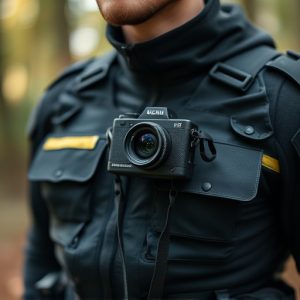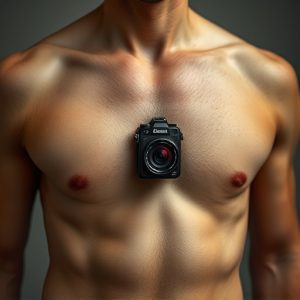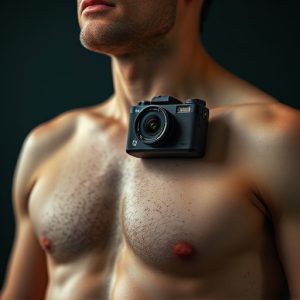Hidden Personal Body Camera Guide: Features, Selection, Legal Use, and Maintenance Tips
Hidden personal body cameras serve as discreet yet powerful recording tools, offering first-person p…….
Hidden personal body cameras serve as discreet yet powerful recording tools, offering first-person perspectives ideal for capturing sensitive situations securely. These devices are advantageous for personal safety, providing high-quality evidence that can deter criminal activity and be used reliably in legal contexts. When selecting one, consider environmental durability, legal compliance, resolution, battery life, and storage capacity to suit your specific needs. It's crucial to understand privacy laws and respect individual privacy rights when using these cameras, as unauthorized recording can lead to legal consequences. Efficient power management, such as adjusting settings and using external power sources, extends recording times. High-capacity storage with expandable memory options and secure data retrieval systems are essential for long-term use, ensuring continuous operation and the ability to protect and easily access footage. Regular backups with encryption and strict access controls help maintain the privacy and integrity of the recordings, making them reliable for review or legal purposes. Always stay informed about local laws regarding their use to avoid any legal entanglements.
When safeguarding one’s well-being or documenting experiences, a hidden personal body camera offers unparalleled protection and insight. This article delves into the utility of these devices, highlighting their features, benefits, and how they can be tailored to individual needs. We’ll explore the nuances of selecting the best model for your circumstances, addressing legal constraints associated with their use, and optimizing battery performance. Additionally, we’ll cover data storage strategies and retrieval techniques to ensure you capture and preserve critical moments effectively. Understanding these aspects is key to leveraging a hidden personal body camera as a discreet yet powerful tool for security and documentation.
Understanding Personal Body Cameras: Features and Benefits
Personal body cameras, often referred to as hidden personal body cameras, have become increasingly popular for a variety of reasons. These compact and discreet devices are designed to record interactions and events from a first-person perspective, providing an unobstructed view of the environment and the activities taking place around the wearer. A key feature of these cameras is their stealth nature, allowing users to capture footage without drawing attention, which is particularly useful in sensitive environments or situations where surveillance is required but visibility is a concern.
One of the primary benefits of hidden personal body cameras is their ability to enhance personal safety and security. Users can record potentially threatening encounters with law enforcement, security personnel, or other individuals, ensuring that any misconduct is documented. Additionally, these cameras can be instrumental in deterring criminal activity, as potential offenders are less likely to engage in harmful behavior when they know they’re being recorded. The high-quality video and audio capture capabilities of these devices mean that the evidence collected is often clear enough for identification purposes and legal proceedings. Furthermore, many hidden personal body cameras come equipped with features such as motion detection, night vision, and built-in storage, making them versatile tools for surveillance in a wide range of scenarios. The footage they provide can be invaluable in resolving disputes, improving accountability, and maintaining transparency in various settings, from personal security to professional environments.
Selecting the Right Hidden Personal Body Camera for Your Needs
When in the market for a hidden personal body camera, it’s crucial to consider the specific context and conditions under which you intend to use the device. Factors such as the environment, legal considerations, battery life, resolution, and storage capacity are all vital components that will influence your choice. The environment in which the camera will be used should dictate its durability and weather resistance; for example, a waterproof model would be ideal for outdoor activities or in wet conditions. Additionally, the camera’s resolution must align with the level of detail you require for capturing events accurately. High-definition footage is essential for clarity, which can be pivotal in identifying details or substantiating claims.
Battery longevity is another significant aspect to consider when selecting a hidden personal body camera. A device with an extended battery life ensures uninterrupted surveillance and less frequent charging, which is particularly important during critical moments or prolonged use. Concurrently, storage capacity is equally important as it determines how much footage the camera can record before needing to offload data. Opting for models with expandable memory can be advantageous, providing ample space for storing hours of video evidence. Additionally, ensure that the camera’s design and form factor are conducive to your activities; after all, a hidden personal body camera should remain inconspicuous and unobtrusive while operational.
Legal Considerations When Using Hidden Personal Body Cameras
When incorporating hidden personal body cameras into surveillance practices, it is imperative to navigate the complex web of legal standards and regulations that govern their use. Privacy laws vary by jurisdiction and can significantly impact how such devices may be lawfully employed. For instance, recording individuals without their consent may violate privacy rights and could lead to legal repercussions in many regions. Users must understand and adhere to local surveillance laws, which dictate when and where it is permissible to record public or private activity. Additionally, the ethical implications of covert recording should be carefully considered; the use of hidden personal body cameras must align with societal norms and respect individual privacy boundaries.
Understanding the legal landscape is crucial for anyone considering the use of a hidden personal body camera. This includes recognizing the necessity to inform relevant parties when in settings where there is a reasonable expectation of privacy, such as inside someone’s home or within private establishments. In public spaces, the rules are generally more permissive, but even then, it is advisable to be aware of state or local laws that might impose restrictions. The implications of misuse—such as infringing on civil liberties or capturing sensitive information without consent—can lead to criminal charges and civil lawsuits. Therefore, users must remain vigilant and well-informed about the legal parameters governing the use of hidden personal body cameras in their specific context to avoid unintended legal issues.
Maximizing Battery Life in Your Hidden Personal Body Camera
When utilizing a hidden personal body camera for surveillance purposes, maximizing battery life is crucial to ensure that your device operates when needed most. To extend the battery longevity of your hidden personal body camera, it’s essential to manage power consumption effectively. Begin by familiarizing yourself with the camera’s power settings and default recording times. Optimal settings can significantly influence how long your camera will run before needing a recharge. Pre-set your device to record in lower resolutions or reduce the frequency of status indicator lights when not in use, as these features can drain battery life quickly.
Additionally, consider investing in an external power bank compatible with your hidden personal body camera. This allows for extended recording sessions without interruption. Positioning the camera so that it captures the desired area while minimizing unnecessary movement can also conserve energy. Regularly update the software of your camera as updates may include battery-saving enhancements. Lastly, store your device in a cool, dry place away from direct sunlight when not in use to prevent battery degradation. By implementing these strategies, you can ensure that your hidden personal body camera remains ready for surveillance whenever it’s needed.
Data Storage and Retrieval with Hidden Personal Body Cameras: Best Practices
When utilizing a hidden personal body camera for surveillance purposes, data storage and retrieval are critical components that determine the effectiveness of the footage captured. It is imperative to choose a device with ample storage capacity to accommodate the high-resolution video it records. High-definition footage consumes more space, so opting for a camera with expandable memory, such as microSD cards, allows for extended recording times and the ability to store multiple events or shifts. Best practices suggest setting up the camera to overwrite older footage once the storage limit is reached, ensuring continuous recording without manual intervention.
Retrieval of data from hidden personal body cameras should be straightforward and secure. The device should support easy transfer of files to a computer or cloud storage for safekeeping. Ensuring that data can be encrypted during transmission and upon storage further safeguards the privacy and integrity of the footage. Regular backups are essential to prevent data loss in case of device malfunction or theft. It is also advisable to implement strict access controls and maintain a log of who accesses the recordings, when, and for what purpose, to uphold accountability and maintain the legal admissibility of the footage in question. Adhering to these best practices will not only enhance the quality of surveillance but also ensure that the data collected is reliable and can be effectively used when needed.


